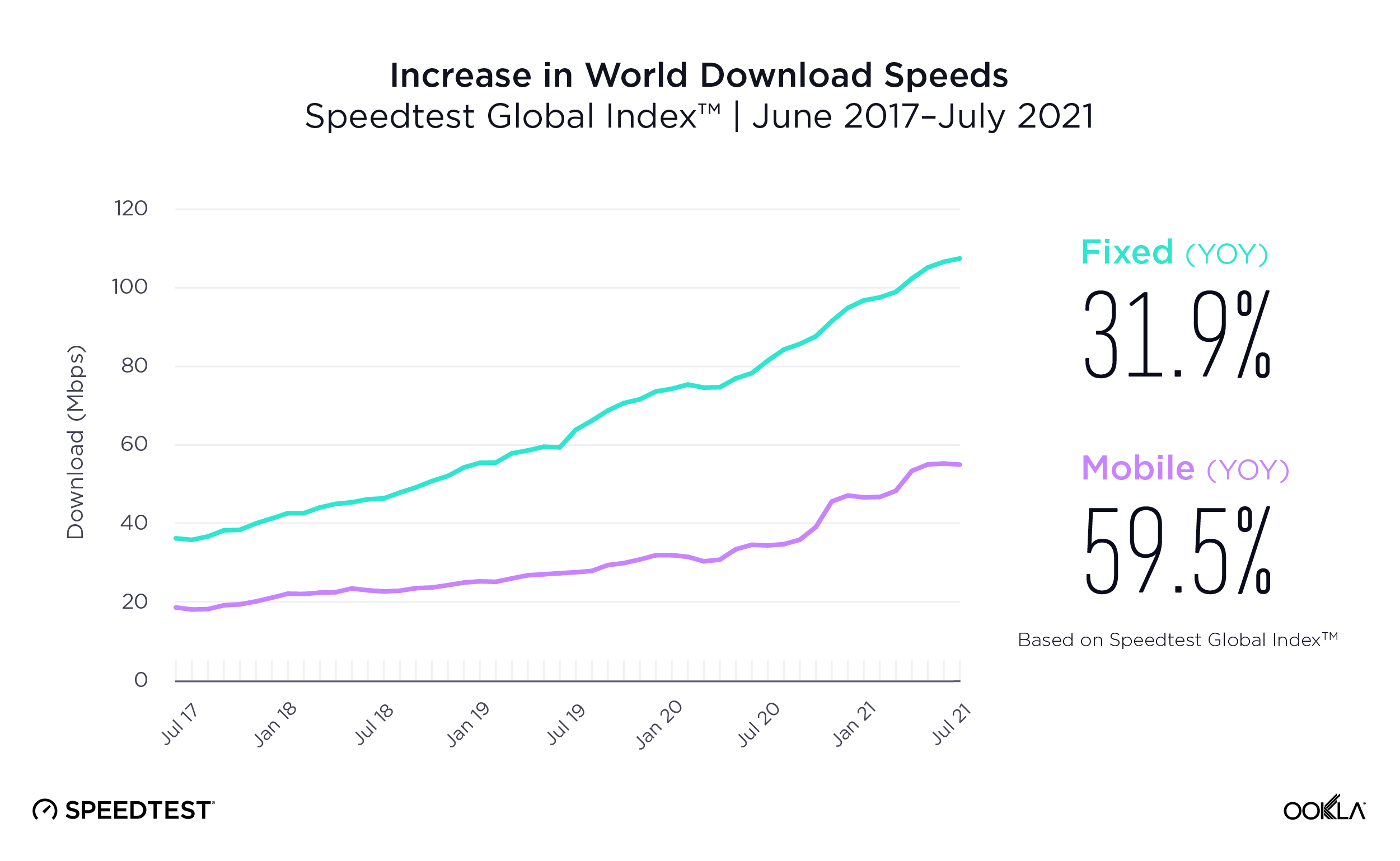Despite perennial complaints that internet access simply is not available enough, cheap enough or good enough, global internet access keeps getting faster, more available and arguably even more affordable.
According to Ookla, mobile download speed improved 60 percent over the last year globally, while fixed broadband speeds got 32 percent faster.
The global mean of download speeds improved over the last 12 months on both mobile and fixed broadband to 55.07 Mbps (mobile) and 107.50 Mbps (fixed network) in July 2021, Ookla says.
Mean (average) download speed over mobile was 99 percent faster in July 2021 than in July 2019, 141 percent faster when comparing July 2021 to July 2018, and 194 percent faster when comparing July 2021 to June 2017. 
source: Ookla
On fixed networks, mean download speed was 68 percent faster in July 2021 than in July 2019, 131 percent faster in July 2021 than in July 2018 and 196 percent faster in July 2021 than in June 2017.
On the price front, observers sometimes cite posted retail prices and argue that “ prices are too high.” That remains true in many developing countries, but in developed countries the story is not correct. Internet access is not very expensive.
When some claim prices are too high, the typical argument is that U.S. a la carte prices (the retail tariff for internet access, not purchased in a bundle) are higher than prices in other countries.
Adjusting for currency and living cost differentials, however, broadband access prices globally are remarkably uniform.
The 2019 average price of a broadband internet access connection--globally--was $72..92, down $0.12 from 2017 levels, according to comparison site Cable. Other comparisons say the average global price for a fixed connection is $67 a month.
Looking at 95 countries globally with internet access speeds of at least 60 Mbps, U.S. prices were $62.74 a month, with the highest price being $100.42 in the United Arab Emirates and the lowest price being $4.88 in the Ukraine.
According to comparethemarket.com, the United States is not the most affordable of 50 countries analyzed. On the other hand, the United States ranks fifth among 50 for downstream speeds.
Another study by Deutsche Bank, looking at cities in a number of countries, with a modest 8 Mbps rate, found prices ranging between $50 to $52 a month. That still places prices for major U.S. cities such as New York, San Francisco and Boston at the top of the price range for cities studied, but do not seem to be adjusted for purchasing power parity, which attempts to adjust prices based on how much a particular unit of currency buys in each country.
The other normalization technique used by the International Telecommunications Union is to attempt to normalize by comparing prices to gross national income per person. There are methodological issues when doing so, one can argue. Gross national income is not household income, and per-capita measures might not always be the best way to compare prices, income or other metrics. But at a high level, measuring prices as a percentage of income provides some relative measure of affordability.
Looking at internet access prices using the PPP method, developed nation prices are around $35 to $40 a month. In absolute terms, developed nation prices are less than $30 a month.
According to a new analysis by NetCredit, which shows U.S. consumers spending about 0.16 percent of income on internet access, “making it the most affordable broadband in North America,” says NetCredit.
In Europe, a majority of consumers pay less than one percent of their average wages to get broadband access, NetCredit says. In Singapore, Hong Kong, New Zealand and Japan, 10 Mbps service costs between 0.15 percent and 0.28 percent of income.
A normalization technique used by the International Telecommunications Union is to attempt to compare prices to gross national income per person, or to adjust posted retail prices using a purchasing power parity method.

source: ITU
Gross national income is not household income, and per-capita measures might not always be the best way to compare prices, income or other metrics. But at a high level, measuring prices as a percentage of income provides some relative measure of affordability.
Looking at internet access prices using the purchasing power parity method, developed nation prices are around $35 to $40 a month. In absolute terms, developed nation prices are less than $30 a month.
First of all, the product people buy is different over time. Customers are buying faster packages than they used to. To the extent that faster tiers of service cost more, “average” prices will climb. On a cost-per-Mbps basis, costs are dropping.
But there are limits to price levels. Consumers will only spend so much on internet access. That figure tends to a small percent of household income, with all forms of communication service spending amounting to perhaps
Prices for fixed network service have dropped about 92 percent over the last decade, for example, on a cost-per-megabit-per-second basis. Customers also use much more data than they used to, as well. Competition accounts for some of the improvement, even if observers sometimes argue “there is no competition” for consumer broadband services.
The point is that internet access keeps getting better, and more affordable as well.
